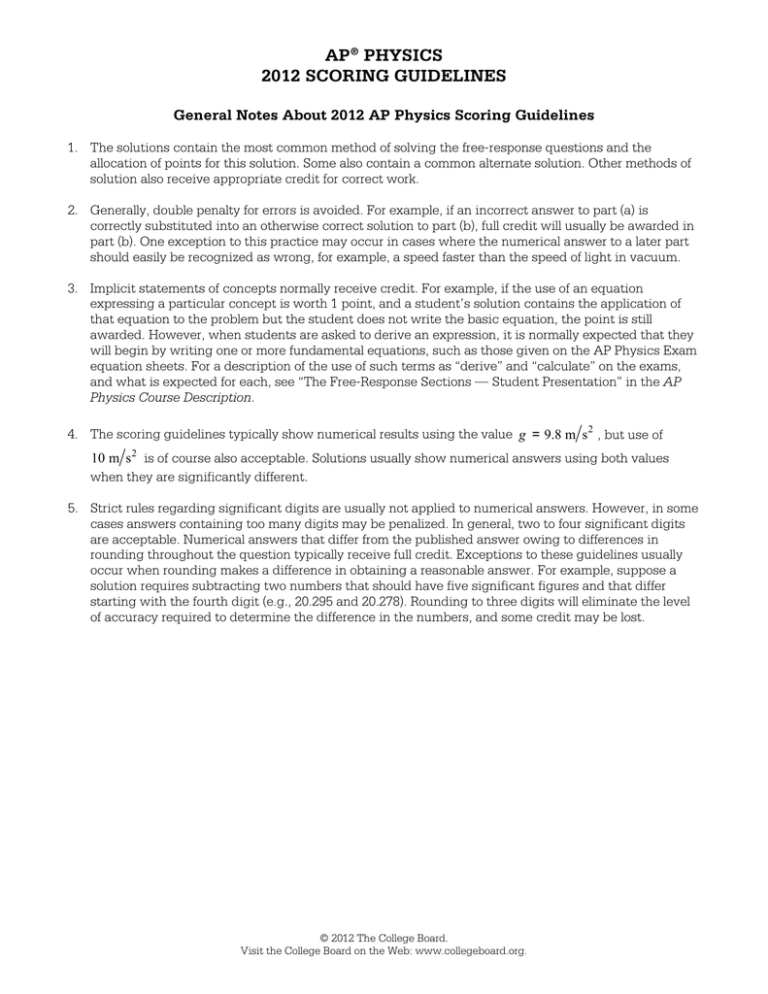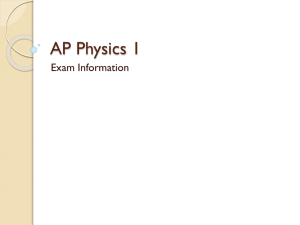AP® PHYSICS 2012 SCORING GUIDELINES
advertisement

AP® PHYSICS 2012 SCORING GUIDELINES General Notes About 2012 AP Physics Scoring Guidelines 1. The solutions contain the most common method of solving the free-response questions and the allocation of points for this solution. Some also contain a common alternate solution. Other methods of solution also receive appropriate credit for correct work. 2. Generally, double penalty for errors is avoided. For example, if an incorrect answer to part (a) is correctly substituted into an otherwise correct solution to part (b), full credit will usually be awarded in part (b). One exception to this practice may occur in cases where the numerical answer to a later part should easily be recognized as wrong, for example, a speed faster than the speed of light in vacuum. 3. Implicit statements of concepts normally receive credit. For example, if the use of an equation expressing a particular concept is worth 1 point, and a student’s solution contains the application of that equation to the problem but the student does not write the basic equation, the point is still awarded. However, when students are asked to derive an expression, it is normally expected that they will begin by writing one or more fundamental equations, such as those given on the AP Physics Exam equation sheets. For a description of the use of such terms as “derive” and “calculate” on the exams, and what is expected for each, see “The Free-Response Sections — Student Presentation” in the AP Physics Course Description. 4. The scoring guidelines typically show numerical results using the value g = 9.8 m s 2 , but use of 10 m s 2 is of course also acceptable. Solutions usually show numerical answers using both values when they are significantly different. 5. Strict rules regarding significant digits are usually not applied to numerical answers. However, in some cases answers containing too many digits may be penalized. In general, two to four significant digits are acceptable. Numerical answers that differ from the published answer owing to differences in rounding throughout the question typically receive full credit. Exceptions to these guidelines usually occur when rounding makes a difference in obtaining a reasonable answer. For example, suppose a solution requires subtracting two numbers that should have five significant figures and that differ starting with the fourth digit (e.g., 20.295 and 20.278). Rounding to three digits will eliminate the level of accuracy required to determine the difference in the numbers, and some credit may be lost. © 2012 The College Board. Visit the College Board on the Web: www.collegeboard.org. AP® PHYSICS C: ELECTRICITY AND MAGNETISM 2012 SCORING GUIDELINES Question 3 15 points total (a) Distribution of points 1 point fm = Ú B dA For a correct answer fm = B0 Lh0 (b) 1 point 2 points For a correct direction arrow 1 point For a valid justification using Lenz’s Law or the right-hand rule, if the direction is also correct 1 point Examples The flux is decreasing as the area is decreasing, and a current to the right would cause an inward magnetic field that would increase flux. The force on the falling positive charge carriers is to the right, which causes a conventional current to the right. (c) 3 points For a correct relationship between current, voltage, and resistance I = e 1 point R For a correct relationship between the induced emf and the magnetic field e = ddtfm e = B0 L dh dt e = B0 Lu 1 point For a correct answer I = B0 Lu R 1 point Note: If only the correct answer is given, with no accompanying work, only 1 point can be awarded. © 2012 The College Board. Visit the College Board on the Web: www.collegeboard.org. AP® PHYSICS C: ELECTRICITY AND MAGNETISM 2012 SCORING GUIDELINES Question 3 (continued) Distribution of points (d) 4 points For a correct net force equation showing opposite directions for the gravitational and magnetic forces, Fg and FM Â F = ma = Fg - FM a=g- 1 point = mg - FM FM m For using an appropriate equation to find FM 1 point FM = Ú I d ᐉ ¥ B = ILB0 For substituting the current from part (c) B 2 L2 u Ê B Lu ˆ FM = Á 0 ˜ LB0 = 0 Ë R ¯ R 1 point For expressing acceleration a as du dt 1 point B 2 L2 u du =g- 0 dt mR (e) 2 points For setting the gravitational force equal to the magnetic force a = 0; therefore FM = Fg 1 point For correct substitution of expressions for the forces 1 point mg = ILB0 = uT = B02 L2uT R mgR B02 L2 Note: If the correct expression for uT is stated without support, 2 points are awarded. © 2012 The College Board. Visit the College Board on the Web: www.collegeboard.org. AP® PHYSICS C: ELECTRICITY AND MAGNETISM 2012 SCORING GUIDELINES Question 3 (continued) Distribution of points (f) 3 points For correctly checking “Increases” 1 point Note: If an incorrect choice is made for the change in terminal speed, the justification points cannot be earned. For indicating the inverse relationship between resistance and current 1 point For indicating that a smaller current produces a smaller magnetic force on the bar, leading to the conclusion that to achieve a magnetic force equal to the bar’s weight, the bar must be moving faster to produce the necessary current in the bar. 1 point Note: If the only justification is stating that uT μ R from the equation for uT in part (e), only 1 justification point is awarded, because the question specifically asks for the answer in terms of forces on the crossbar. © 2012 The College Board. Visit the College Board on the Web: www.collegeboard.org. © 2012 The College Board. Visit the College Board on the Web: www.collegeboard.org. © 2012 The College Board. Visit the College Board on the Web: www.collegeboard.org. © 2012 The College Board. Visit the College Board on the Web: www.collegeboard.org. © 2012 The College Board. Visit the College Board on the Web: www.collegeboard.org. © 2012 The College Board. Visit the College Board on the Web: www.collegeboard.org. © 2012 The College Board. Visit the College Board on the Web: www.collegeboard.org. AP® PHYSICS C: ELECTRICITY AND MAGNETISM 2012 SCORING COMMENTARY Question 3 Overview This question assessed students’ understanding of Faraday’s and Lenz’s Laws in the scenario of dropping a bar in a uniform magnetic field. Sample: E3-A Score: 13 This is an excellent and well-organized response. Points were lost only in part (c). When the question says to “calculate,” students must show their work to receive full credit. This response received only 1 point in part (c) for the correct answer. Also note that in part (b) no penalty was imposed for giving a direction to the flux, even though it is a scalar. Sample: E3-B Score: 9 The answer in part (a) is incorrect and earned no credit. In part (b) 1 point was earned for the correct direction, but the justification is insufficient. Full credit was earned in parts (c), (e), and (f). Part (d) shows no useful work, so no credit was awarded. Sample: E3-C Score: 6 Full credit was earned in parts (a) and (b). In parts (c) and (e) no useful work is presented, so no credit was awarded. Two points were earned in part (d) for the correct expression of magnetic force and for substituting dv/dt for a. In part (f) 1 point was earned for selecting the correct answer, but the justification is insufficient. © 2012 The College Board. Visit the College Board on the Web: www.collegeboard.org.


